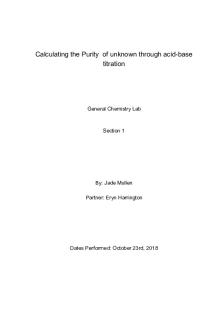Chem106 Acid base titration postlab PDF

| Title | Chem106 Acid base titration postlab |
|---|---|
| Course | [P] Principles Of Chemistry Ii |
| Institution | Washington State University |
| Pages | 2 |
| File Size | 141.6 KB |
| File Type | |
| Total Downloads | 52 |
| Total Views | 157 |
Summary
postlab for acid base titration laboratory...
Description
Serena Beltramo October 23, 2020 Lab Section 02 Data Set 2
Acid-Base Titration lab Data Observations: • Before adding any NaOH, we added one 10.00 mL pipette of 0.21 M Oxalic acid to an empty 250 mL beaker, and then added some DI water so the probe would be able to be fully submerged in the solution, a stir bar was then added to the beaker and the beaker was placed on a stir plate. NaOH was then put into a 25.00 mL burette for later titration. • In the titration, I would have slowly opened the burette to add NaOH either until the pH is raised by 0.2 units or until 0.50 mL has been added, then the pH and burette values would be recorded. This process would be repeated until I hit 11.4 pH or emptied my burette. When I hit an equivalence point it would be seen that the pH would rapidly change so I would slow down and titrate very slowly. The known acid was oxalic acid. Calculations:
pH vs. mL Base Added 7 6
pH of solution
5 4 3 2 1 0 0.00
2.00
4.00
6.00
8.00
10.00
12.00
14.00
16.00
mL Base added
1. 2. 1st equivalence point=(8.11, 2.95) 2nd equivalence point (16.22, 5.9) (based on plot) !.## a. = 4.055 = $ 1𝑠𝑡)ℎ𝑎𝑙𝑓)𝑒𝑞𝑢𝑖𝑣𝑎𝑙𝑒𝑛𝑐𝑒)𝑝𝑜𝑖𝑛𝑡, 𝑐𝑜𝑟𝑟𝑒𝑠𝑝𝑜𝑛𝑑𝑖𝑛𝑔)𝑝𝐻)𝑣𝑎𝑙𝑢𝑒)𝑤𝑎𝑠)1.34 𝑝𝐾𝑎 = 1.34)𝑏𝑒𝑐𝑎𝑢𝑠𝑒)𝑝𝐾𝑎 = 𝑝𝐻) b. 8.11 + 4.055 = 12.17 = 𝑠𝑒𝑐𝑜𝑛𝑑)ℎ𝑎𝑙𝑓)𝑒𝑞𝑢𝑖𝑣𝑎𝑙𝑒𝑛𝑐𝑒)𝑝𝑜𝑖𝑛𝑡 pKa= 4.065 c. 𝑝𝐾𝑎# = − log[𝐾𝑎#] → 𝐾𝑎# = 10%&'(! → 𝐾𝑎 = 10%#.)* = 0.046 Ka1=0.046
18.00
d. 𝑝𝐾𝑎$ = − log[𝐾𝑎$] → 𝐾𝑎$ = 10%&'(" → 𝐾𝑎$ = 10%*.+,- → 𝐾𝑎$ = 8.61𝑥 10%3. The actual pKa value of oxalic acid is 1.25 for pKa1 and 4.28 for pKa2. The website used was https://pubchem.ncbi.nlm.nih.gov/compound/Oxalic-acid. The percent difference for pKa1 was 2.18% and 0.637% for pKa2. Results and Discussion: 1. In this lab, the goal was to be able to determine pKa values from titration data collected. In order to do this, the LoggerPro program was used to read the pH of the buffer solution. Then, the NaOH solution was titrated into a 150ml beaker using a burette, adding varying amounts until the solutions pH hit 11.4 or the burette ran out of solution to use. This was done to find where our titrations approached the equivalence points. The pKa values I calculated for this were 1.34 and 4.07, and the Ka values were 0.046 and 8.61x10-3. My values were close to the actual pKa values of Oxalic Acid. 2. Since there was not a super large difference between the acids actual and calculated pKa values, it indicates that the pKa assay was fairly accurate, since my first pKa value was further off than my second it may indicate that my data was a little off. 3. Experimentally, adding too much NaOH at a time when titrating could have caused a larger pH change earlier on, which could have caused my pKa values to be a little bit too high or low, and therefore also the Ka if I had interpreted that to be the start of the equivalency point. 4. The amounts are as stated below 1. There is more HA than anything else 2. There is more HA but A is growing 3. It is about ¾ HA and ¼ A 4. Between this point HA and A are approaching equal amounts but HA still has more 5. The amounts of HA and A are equal 6. The amount of HA grows to outbalance A again 7. There is about ¾ HA and ½ A again 8. Between this point HA and A are approaching equal amounts but HA still has more 9. The amounts of HA and A are equal 10. HA outnumbers A again...
Similar Free PDFs

Acid Base Titration
- 7 Pages

Acid Base Titration
- 15 Pages

Acid Base Titration
- 6 Pages

Afl Acid-Base Titration
- 6 Pages

Acid base titration lab report
- 5 Pages

Acid-Base Titration Lab Report
- 7 Pages

Exp 08 Acid-Base Titration
- 10 Pages

Acid Base Titration 08 2019
- 11 Pages

Acid-Base Titration Pre-Lab
- 4 Pages
Popular Institutions
- Tinajero National High School - Annex
- Politeknik Caltex Riau
- Yokohama City University
- SGT University
- University of Al-Qadisiyah
- Divine Word College of Vigan
- Techniek College Rotterdam
- Universidade de Santiago
- Universiti Teknologi MARA Cawangan Johor Kampus Pasir Gudang
- Poltekkes Kemenkes Yogyakarta
- Baguio City National High School
- Colegio san marcos
- preparatoria uno
- Centro de Bachillerato Tecnológico Industrial y de Servicios No. 107
- Dalian Maritime University
- Quang Trung Secondary School
- Colegio Tecnológico en Informática
- Corporación Regional de Educación Superior
- Grupo CEDVA
- Dar Al Uloom University
- Centro de Estudios Preuniversitarios de la Universidad Nacional de Ingeniería
- 上智大学
- Aakash International School, Nuna Majara
- San Felipe Neri Catholic School
- Kang Chiao International School - New Taipei City
- Misamis Occidental National High School
- Institución Educativa Escuela Normal Juan Ladrilleros
- Kolehiyo ng Pantukan
- Batanes State College
- Instituto Continental
- Sekolah Menengah Kejuruan Kesehatan Kaltara (Tarakan)
- Colegio de La Inmaculada Concepcion - Cebu






